Text
Sports Medicine: Advances in Injury Prevention, Treatment, and Rehabilitation

Sports medicine is a multidisciplinary field dedicated to optimizing athletic performance, preventing sports-related injuries, and promoting the physical well-being of athletes. With advancements in research, technology, and treatment modalities, sports medicine professionals continuously strive to enhance injury prevention strategies, refine treatment protocols, and expedite rehabilitation. Let’s explore some recent developments in sports medicine that are revolutionizing how athletes train, compete, and recover.
1. Injury Prevention Programs
Prevention is paramount in sports medicine, and innovative injury prevention programs are increasingly being implemented to reduce the risk of common sports injuries. These programs often incorporate dynamic warm-up exercises, neuromuscular training, proprioceptive drills, and movement assessments to improve biomechanics, enhance stability, and mitigate injury risk. By addressing muscular imbalances, movement deficiencies, and faulty mechanics, athletes can minimize the likelihood of sustaining injuries during training and competition.
2. Biomechanical Analysis
Biomechanical analysis advancements have revolutionised how sports injuries are diagnosed and treated. High-tech tools such as motion capture systems, force plates, and wearable sensors allow sports medicine professionals to assess real-time movement patterns, joint kinetics, and muscle activation. By identifying biomechanical abnormalities and asymmetries, clinicians can tailor rehabilitation programs and corrective exercises to address underlying issues and optimize athletic performance while reducing injury risk.
3. Regenerative Medicine
Regenerative medicine holds promise for accelerating the healing process and promoting tissue repair in sports-related injuries. Techniques such as platelet-rich plasma (PRP), stem cells, and prolotherapy harness the body’s natural healing mechanisms to stimulate tissue regeneration and reduce inflammation. These minimally invasive treatments offer athletes a non-surgical alternative for managing chronic conditions such as tendonitis, ligament injuries, and osteoarthritis, allowing for faster recovery and return to play.
4. Telemedicine and Remote Monitoring
The advent of telemedicine and remote monitoring technologies has transformed the delivery of sports medicine services, particularly in the era of global pandemics and social distancing measures. Virtual consultations, telerehabilitation sessions, and remote monitoring platforms enable athletes to receive timely medical advice, access personalized exercise programs, and track their progress from the comfort of their homes or training facilities. This expanded access to healthcare facilitates early intervention, promotes continuity of care, and enhances athlete compliance with treatment plans.
5. Integrative Rehabilitation Approaches
Integrative rehabilitation combines traditional physical therapy modalities with complementary therapies such as acupuncture, chiropractic care, massage therapy, and mind-body techniques to optimize recovery and enhance performance. By addressing the physical, psychological, and emotional aspects of injury rehabilitation, these holistic approaches promote overall well-being and facilitate a comprehensive recovery process for athletes.
6. Injury Risk Assessment Tools
Advances in sports science have led to the development of sophisticated injury risk assessment tools that help identify athletes at heightened risk of injury based on various factors such as biomechanics, training load, fatigue, and previous injury history. By utilizing predictive analytics and machine learning algorithms, sports medicine professionals can tailor injury prevention strategies, individualize training programs, and implement targeted interventions to mitigate injury risk and optimize performance.
In conclusion, sports medicine continues to evolve rapidly, driven by innovation, research, and collaboration among healthcare professionals, scientists, coaches, and athletes. By leveraging cutting-edge technologies, evidence-based practices, and a multidisciplinary approach, sports medicine practitioners are advancing the frontiers of injury prevention, treatment, and rehabilitation, ultimately empowering athletes to achieve their full potential and thrive in their respective sports.
0 notes
Text
Outdoor Adventure Sports: Exploring Nature Through Thrilling Activities

In a world dominated by technology and urban landscapes, the allure of outdoor adventure sports offers a refreshing escape into the heart of nature. From the adrenaline rush of whitewater rafting to the serenity of hiking through lush forests, outdoor enthusiasts seek to immerse themselves in the beauty and excitement of the great outdoors. Let’s delve into the world of outdoor adventure sports and explore the exhilarating experiences they offer.
Embracing Nature’s Playground
Outdoor adventure sports encompass various activities that take participants off the beaten path and into nature’s playground. Whether climbing towering mountains, navigating rugged terrain on mountain bikes, or soaring through the air on zip lines, these sports offer a unique blend of physical challenge, mental stimulation, and awe-inspiring scenery. Each adventure allows one to connect with the natural world and experience its wonders firsthand.
Thrills and Challenges
One of the defining characteristics of outdoor adventure sports is the element of risk and challenge they entail. Participants must navigate unpredictable terrain, contend with changing weather conditions, and push their physical and mental limits to overcome obstacles and achieve their goals. Whether conquering a steep rock face, braving Class V rapids, or summiting a remote peak, the sense of accomplishment and empowerment of overcoming challenges in the great outdoors is unparalleled.
Health Benefits
Engaging in outdoor adventure sports offers numerous health benefits beyond the thrill of the experience. Physical activities such as hiking, kayaking, and skiing provide excellent cardiovascular exercise, strengthen muscles, and improve overall fitness. Furthermore, spending time in nature has been shown to reduce stress, lower blood pressure, and boost mood and mental well-being. Combining physical exertion and natural surroundings creates a holistic approach to health and wellness that rejuvenates the body, mind, and spirit.
Environmental Stewardship
While outdoor adventure sports offer unparalleled opportunities for exploration and excitement, they also carry a responsibility to protect and preserve the natural environment. Sustainable practices such as Leave No Trace principles, responsible waste management, and supporting conservation efforts are essential for minimizing the impact of outdoor recreation on fragile ecosystems. By practicing environmental stewardship, outdoor enthusiasts can ensure that future generations have the opportunity to enjoy the beauty and splendor of the outdoors.
Accessible to All
One of the most significant aspects of outdoor adventure sports is their accessibility to people of all ages, abilities, and backgrounds. Whether you’re a seasoned athlete or a novice adventurer, activities and experiences are suited to every skill level and interest. From family-friendly hikes and nature walks to extreme sports and multi-day expeditions, there’s something for everyone to enjoy in the great outdoors. Additionally, outdoor recreation fosters community and camaraderie among participants, creating lasting memories and friendships forged in the wilderness.
Conclusion
Outdoor adventure sports offer a gateway to experiencing the natural world in all its glory, from breathtaking landscapes and diverse ecosystems to thrilling challenges and unforgettable adventures. Whether you seek the rush of adrenaline, the tranquillity of nature, or the camaraderie of fellow adventurers, outdoor sports provide endless opportunities for exploration, growth, and connection with the world around us. So grab your gear, embrace the spirit of adventure, and embark on an epic journey into the great outdoors. The adventure awaits!
0 notes
Text
Sports Photography: Capturing the Essence and Emotion of Athletic Moments

Sports photography is more than just freezing action shots of athletes in motion; it encapsulates athletic competition’s passion, intensity, and raw emotion. From the thrill of victory to the agony of defeat, sports photographers are challenged to tell compelling stories through their images. Let’s explore the art of sports photography and how photographers capture the essence and emotion of athletic moments.
Preparation and Planning
Successful sports photography begins long before the game starts. Preparation is vital, and photographers often research the sport, venue, and athletes involved to anticipate critical moments and positions for capturing impactful images. They scout locations, study lighting conditions, and familiarize themselves with the rules and dynamics of the sport to ensure they’re ready to capture the action as it unfolds.
Equipment and Gear
Sports photography demands specialized equipment designed to capture fast-paced action in challenging environments. High-speed cameras with fast autofocus capabilities, long telephoto lenses, and sturdy tripods or monopods are essential for capturing sharp, detailed images from a distance. Additionally, photographers may use remote triggers, teleconverters, and image stabilization technology to enhance their shooting capabilities and overcome technical challenges.
Composition and Timing
Composition is crucial in sports photography, as photographers strive to create visually dynamic images that convey the energy and excitement of the moment. They carefully frame their shots to highlight the athletes’ athleticism, emotion, and interaction with their surroundings. Timing is everything, and photographers must anticipate decisive moments such as a winning goal, a dramatic dive, or a celebratory gesture to capture the essence of the game.
Emotion and Storytelling
Beyond action shots, sports photography aims to capture the human element of sports—the emotions, reactions, and stories behind the game. Photographers seek out moments of triumph, determination, camaraderie, and heartbreak that resonate with viewers personally. Whether the joyous celebration of a championship victory or the sadness of a missed opportunity, emotive images evoke empathy and connect viewers to the athletes’ experiences.
Creative Techniques
Sports photographers often employ creative techniques such as panning, motion blur, and selective focus to add visual interest and dynamism to their images. By experimenting with shutter speed, aperture, and perspective, photographers can convey a sense of speed, power, and intensity that immerses viewers in the heart of the action. Additionally, incorporating elements such as dramatic lighting, vibrant colors, and striking compositions enhances the visual impact of sports photography.
Ethical Considerations
While capturing captivating images is the goal, sports photographers must also adhere to ethical standards and respect the integrity of the game. They must maintain objectivity, avoid altering or staging images, and prioritize the safety and privacy of athletes and spectators. Additionally, photographers should obtain consent when photographing minors or individuals in vulnerable situations and refrain from intrusive or disrespectful behavior.
Conclusion
Sports photography is a dynamic and exhilarating genre that celebrates the spirit of athleticism and competition. By combining technical expertise, creative vision, and an understanding of human emotion, photographers capture the essence and emotion of athletic moments that transcend the boundaries of time and space. Whether it’s the thrill of victory or the resilience in defeat, sports photography immortalizes the triumphs, struggles, and stories that define the world of sports.
0 notes
Text
Sports in Pop Culture: How Movies, TV Shows, and Music Celebrate the Athletic Spirit
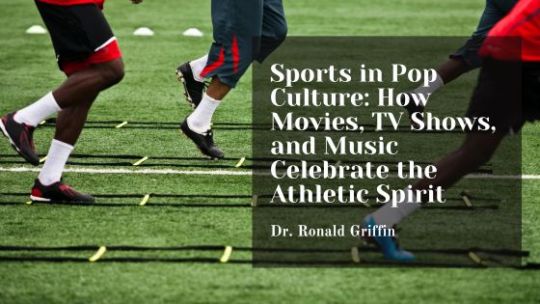
Sports have always held a special place in popular culture, captivating audiences with tales of triumph, defeat, and the human spirit. From iconic sports movies to memorable TV shows and anthemic sports-themed music, the influence of athletics extends far beyond the field, court, or arena. In this blog post, we’ll explore how sports are celebrated in pop culture through movies, TV shows, and music and their impact on audiences worldwide.
1. Sports Movies
Sports movies have been a staple of Hollywood for decades, offering audiences thrilling tales of underdogs, champions, and the power of perseverance. From inspiring true stories to fictional dramas, sports movies capture the drama, excitement, and emotion of athletic competition in a way that resonates with viewers of all ages.
Classic sports films like “Rocky,” “Rudy,” and “Remember the Titans” are beloved for their memorable characters, stirring speeches, and heartwarming moments of triumph over adversity. These movies inspire audiences to believe in themselves, pursue their dreams, and never give up, regardless of their obstacles.
2. Sports TV Shows
Sports-themed TV shows provide viewers with an inside look at the world of athletics, from the highs and lows of professional competition to the personal struggles and triumphs of athletes off the field. Whether it’s a behind-the-scenes documentary series, a fictional drama set in the world of sports, or a reality competition show, sports TV programs offer something for everyone.
Shows like “Friday Night Lights,” “The Last Dance,” and “All or Nothing” give viewers an intimate look at the lives of athletes, coaches, and teams, exploring the dedication, sacrifice, and passion required to succeed in the world of sports. These shows offer compelling storytelling, captivating characters, and a glimpse into the unique culture and camaraderie of the sports world.
3. Sports-themed Music
Music has the power to evoke emotions, capture moments, and inspire action, making it a natural fit for celebrating the spirit of athletics. Sports-themed music, including anthems, pump-up songs, and victory chants, has become integral to the game-day experience, energizing fans and players alike.
Songs like “Eye of the Tiger” by Survivor, “We Will Rock You” by Queen, and “Remember the Name” by Fort Minor have become synonymous with sports culture, serving as rallying cries for athletes and fans around the world. These anthems inspire confidence, ignite passion, and create a sense of unity and camaraderie among sports enthusiasts.
4. Impact on Audiences
Sports in pop culture profoundly impact audiences, inspiring them to dream big, overcome obstacles, and pursue their passions with determination and resilience. Whether through the silver screen, the small screen, or the airwaves, sports stories resonate with viewers on a deep and personal level, tapping into universal themes of hope, perseverance, and the pursuit of excellence.
Sports movies, TV shows, and music celebrate the athletic spirit, showcasing the power of teamwork, perseverance, and determination to overcome challenges and achieve greatness. These stories inspire audiences to push beyond their limits, embrace their inner champions, and find strength and inspiration in sports.
Conclusion
Sports have always been a central part of popular culture, celebrated and cherished by audiences worldwide. Whether through inspiring movies, captivating TV shows, or anthemic music, sports stories resonate with viewers profoundly, capturing athletic competition’s drama, excitement, and emotion.
As sports continue to influence and inspire pop culture, audiences will remain captivated by the timeless tales of triumph, defeat, and the indomitable human spirit that define the world of athletics. Whether on the big screen, the small screen, or the airwaves, sports in pop culture will continue to unite fans, inspire generations, and celebrate the timeless values of teamwork, perseverance, and the pursuit of excellence.
0 notes
Text
The Role of Genetics in Dental Health: Understanding Hereditary Factors

Dental health is influenced by many factors, including oral hygiene practices, diet, lifestyle habits, and genetics. While the importance of proper dental care is widely recognized, the role of genetics in determining oral health outcomes is often overlooked. However, understanding the genetic basis of dental conditions can provide valuable insights into prevention, diagnosis, and treatment strategies. Let’s delve into the fascinating world of genetic influences on dental health.
Genetic Variations and Dental Traits
Human genetics significantly determine dental traits, including tooth size, shape, structure, and susceptibility to certain oral conditions. For example, the size and shape of teeth, such as incisor width and molar morphology, are primarily determined by genetic factors. Similarly, the development of dental anomalies such as missing teeth (hypodontia), extra teeth (hypodontia), and misalignment (malocclusion) can be influenced by genetic variations.
Inherited Dental Disorders
Certain dental conditions have a vital genetic component and can be inherited from parents. Examples of inherited dental disorders include amelogenesis imperfecta, dentinogenesis imperfecta, and ectodermal dysplasia. These disorders affect the development and structure of teeth, leading to abnormalities in enamel, dentin, or overall tooth structure. Genetic mutations associated with these disorders can result in weakened teeth, increased susceptibility to decay, and aesthetic concerns.
Susceptibility to Oral Diseases
Genetics also play a role in determining an individual’s susceptibility to common oral diseases such as periodontal (gum) disease and dental caries (tooth decay). Studies have identified genetic variations that influence the immune response to oral pathogens and the composition of saliva, which plays a crucial role in protecting against dental diseases. Understanding genetic predispositions to oral diseases can help tailor preventive measures and treatment approaches accordingly.
Genetic Testing in Dentistry
Advancements in genetic technology have paved the way for personalized dentistry through genetic testing. Genetic screening can identify individuals at increased risk of certain dental conditions, allowing for early intervention and preventive measures. For example, genetic testing for susceptibility to periodontal disease can inform patients about their risk profile and enable targeted preventive strategies such as more frequent dental cleanings or specialized oral hygiene regimens.
Implications for Dental Treatment
Awareness of genetic factors in dental health can also guide treatment decisions and outcomes. Dentists may consider genetic predispositions when planning orthodontic treatment, restorative procedures, or periodontal therapy. Additionally, knowledge of genetic markers associated with drug metabolism can help optimize medication selection and dosing for dental treatment patients.
Preventive Strategies
While genetics influence dental health outcomes, environmental factors and lifestyle choices also play significant roles. Practicing good oral hygiene, maintaining a balanced diet, avoiding tobacco use, and attending regular dental check-ups are essential for maintaining oral health regardless of genetic predispositions. Additionally, individuals with a family history of certain dental conditions may benefit from early intervention and close monitoring by dental professionals.
In conclusion, genetics play a multifaceted role in dental health, influencing various aspects of tooth development, susceptibility to oral diseases, and response to treatment. By understanding the genetic factors contributing to dental conditions, dental professionals can deliver personalized care and preventive strategies tailored to each individual’s unique genetic profile. Integrating genetic insights into dental practice promises to improve oral health outcomes and enhance patient well-being in the era of precision medicine.
0 notes
Text
Oral Cancer Awareness: Signs, Symptoms, and Prevention Strategies
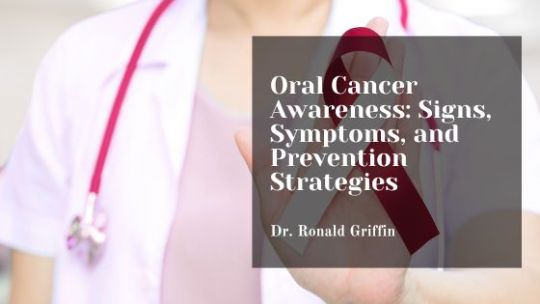
Oral cancer is a serious and potentially life-threatening condition that affects millions of people worldwide. Despite advancements in diagnosis and treatment, early detection remains crucial for improving outcomes. This blog aims to raise awareness about oral cancer by discussing its signs, symptoms, risk factors, and prevention strategies.
Understanding Oral Cancer
Oral cancer refers to cancerous growths that develop in the oral cavity, including the lips, tongue, gums, floor of the mouth, and the roof of the mouth (palate). While tobacco and alcohol use are well-known risk factors for oral cancer, other factors such as human papillomavirus (HPV) infection and sun exposure can also contribute to its development.
Signs and Symptoms
Persistent Mouth Sores: Any sore or ulcer in the mouth that does not heal within two weeks should be evaluated by a healthcare professional.
Red or White Patches: Red or white patches on the lips, gums, tongue, or mouth lining may indicate precancerous or cancerous changes.
Difficulty Swallowing or Chewing: Persistent difficulty in swallowing or chewing, or the sensation of a lump or obstruction in the throat, warrants medical attention.
Chronic Sore Throat or Hoarseness: Persistent sore throat, hoarseness, or voice changes that do not resolve should be evaluated for potential underlying causes, including oral cancer.
Changes in Mouth Sensation: Numbness, pain, or tingling in the mouth or lips, or changes in taste sensation, may indicate nerve involvement associated with oral cancer.
Risk Factors
Tobacco Use: Smoking tobacco products, including cigarettes, cigars, and pipes, significantly increases the risk of oral cancer.
Alcohol Consumption: Heavy and long-term alcohol consumption is a major risk factor for oral cancer, particularly when combined with tobacco use.
HPV Infection: Certain strains of the human papillomavirus (HPV), especially HPV-16, are associated with an increased risk of oral cancer.
Sun Exposure: Prolonged exposure to sunlight increases the risk of lip cancer, especially in individuals with fair skin.
Poor Oral Hygiene: Neglecting oral hygiene practices, such as regular brushing, flossing, and dental check-ups, may contribute to the development of oral cancer.
Prevention Strategies
Tobacco and Alcohol Avoidance: Quitting smoking and limiting alcohol consumption can significantly reduce the risk of oral cancer.
Healthy Diet: A balanced diet rich in fruits, vegetables, and whole grains provides essential nutrients and antioxidants that help maintain oral health and reduce cancer risk.
Sun Protection: Using lip balms or lipsticks with a sun protection factor (SPF), wearing wide-brimmed hats, and avoiding excessive sun exposure can help prevent lip cancer.
Regular Dental Check-ups: Routine dental examinations allow for the early detection of oral abnormalities and facilitate timely intervention if necessary.
HPV Vaccination: Vaccination against HPV, especially for adolescents and young adults, can reduce the risk of HPV-related oral cancers.
Conclusion
Oral cancer is a significant public health concern with potentially devastating consequences if not detected and treated early. By recognizing the signs and symptoms of oral cancer, understanding the associated risk factors, and adopting preventive measures, individuals can take proactive steps to protect their oral health and reduce their risk of developing this disease. Regular dental check-ups, healthy lifestyle choices, and sun protection are essential for oral cancer prevention. Increasing awareness about oral cancer and promoting early detection can ultimately save lives and improve outcomes for those affected by this condition.
0 notes
Text
Sustainable Dentistry: Eco-Friendly Practices for a Greener Dental Office
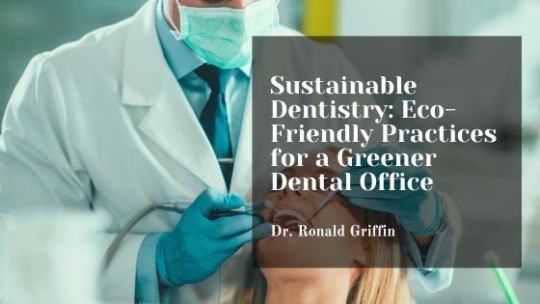
Sustainability has gained significant traction in recent years across various industries, including healthcare. Dentistry, as an integral part of healthcare, is no exception. With growing environmental concerns, dental professionals increasingly embrace eco-friendly practices to minimize their carbon footprint and promote sustainability. Let’s explore some sustainable initiatives that can transform a dental office into a greener, more environmentally conscious space.
1. Energy-Efficient Equipment
One of the primary steps towards sustainable dentistry is investing in energy-efficient equipment. Upgrading to energy-saving dental chairs, LED lighting, and low-energy appliances can significantly reduce electricity consumption and lower operating costs. Opting for equipment with eco-friendly certifications, such as ENERGY STAR, also ensures that the practice adheres to stringent environmental standards.
2. Digital Radiography
Traditional film-based dental X-rays consume large amounts of resources and generate hazardous waste in the form of chemical developers and fixers. Transitioning to digital radiography eliminates the need for film processing chemicals, reducing waste and minimizing environmental impact. Digital X-ray systems also require lower radiation doses, ensuring safer imaging for patients and staff.
3. Eco-Friendly Materials
Dental offices can minimize their environmental footprint by incorporating eco-friendly materials into their practices. From biodegradable patient bibs and disposable cups to recyclable paper products and compostable sterilization pouches, numerous sustainable alternatives are available in the market. Additionally, sourcing dental supplies from environmentally responsible manufacturers ensures that the supply chain upholds sustainable practices.
4. Water Conservation
Conserving water is another crucial aspect of sustainable dentistry. Installing water-saving devices such as low-flow faucets, aerators, and dual-flush toilets can significantly reduce water consumption without compromising functionality. Dental practices can also implement water recycling systems to treat and reuse wastewater generated during procedures, minimizing water wastage.
5. Green Building Design
Adopting green building principles for dental offices undergoing renovation or construction can have a lasting environmental impact. Incorporating energy-efficient insulation, natural lighting, and sustainable building materials reduces energy consumption, improves indoor air quality, and enhances overall comfort for patients and staff. Moreover, green building certifications like LEED (Leadership in Energy and Environmental Design) demonstrate a commitment to environmental stewardship and sustainability.
6. Waste Management and Recycling
Proper waste management is essential for a sustainable dental practice. Implementing comprehensive recycling programs for paper, plastics, glass, and metals reduces landfill waste and conserves valuable resources. Additionally, practices can explore alternative waste disposal methods, such as dental amalgam separators, to prevent mercury contamination of wastewater and comply with environmental regulations.
7. Patient Education and Engagement
Educating patients about the importance of sustainable dentistry empowers them to make environmentally conscious choices. Providing information on eco-friendly dental products, encouraging digital communication and electronic record-keeping, and promoting sustainable oral hygiene practices contribute to a culture of sustainability within the dental community.
In conclusion, sustainable dentistry offers a holistic approach to oral healthcare that prioritizes environmental responsibility and resource conservation. By adopting eco-friendly practices, dental offices can minimize their ecological footprint, reduce operating costs, and contribute to a healthier planet for future generations. Embracing sustainability is a moral imperative and a strategic investment in the long-term viability of the dental profession.
0 notes
Text
Teeth Grinding (Bruxism): Risks, Complications, and Treatment Options

Teeth grinding, medically known as bruxism, is a common dental condition affecting millions worldwide. Often a subconscious behavior, bruxism can lead to various risks and complications if left untreated. Understanding the causes, risks, and available treatment options is crucial for managing this condition effectively.
What is Bruxism?
Bruxism refers to the involuntary grinding, clenching, or gnashing of teeth, typically occurring during sleep. However, it can also manifest during waking hours, albeit less frequently. This condition can affect individuals of all ages, from children to adults.
Risks of Bruxism
Dental Damage: The constant grinding and clenching exert excessive pressure on the teeth, leading to wear, chipping, and even fractures. Over time, this can necessitate extensive dental procedures such as crowns, bridges, or implants.
TMJ Disorders: Bruxism can strain the temporomandibular joint (TMJ), causing pain, stiffness, and difficulty in jaw movement. TMJ disorders can significantly impact one’s quality of life, affecting activities such as eating and speaking.
Headaches and Facial Pain: The muscular strain from bruxism often results in tension headaches, facial pain, and earaches. Chronic discomfort can impair daily functioning and contribute to stress and anxiety.
Sleep Disturbances: Bruxism can disrupt sleep patterns, leading to poor sleep quality and daytime fatigue. Partners of individuals with severe bruxism may also experience disturbances due to the noise generated by teeth grinding.
Complications Associated with Bruxism
Gum Recession: The constant pressure on the teeth and gums can lead to gum recession, exposing the sensitive tooth roots and increasing the risk of decay and tooth loss.
Tooth Sensitivity: Abrasion of tooth enamel resulting from bruxism can cause heightened sensitivity to hot, cold, or sweet foods and beverages, leading to discomfort and pain.
Occlusal Issues: Bruxism can alter the alignment of teeth, resulting in bite misalignment (malocclusion). This can further exacerbate grinding and clenching, creating a vicious cycle of dental problems.
Psychological Impact: Chronic bruxism can contribute to stress, anxiety, and depression, especially if the condition leads to significant dental damage or sleep disturbances.
Treatment Options
Mouthguards or Splints: Custom-fitted mouthguards or splints are often recommended to protect the teeth from grinding during sleep. These dental appliances create a barrier between the upper and lower teeth, preventing wear and damage.
Stress Management Techniques: Since stress and anxiety are common triggers for bruxism, practicing relaxation techniques such as deep breathing, meditation, or yoga can help alleviate symptoms. Counseling or therapy may also be beneficial in addressing underlying emotional stressors.
Behavioral Therapy: Cognitive-behavioral therapy (CBT) can help individuals identify and modify the behaviors and thought patterns contributing to bruxism. Techniques such as habit-reversal training can aid in breaking the habit of teeth grinding.
Medications: In some cases, muscle relaxants or anti-anxiety medications may be prescribed to alleviate muscular tension and reduce bruxism symptoms, mainly if stress or anxiety is a significant contributing factor.
Conclusion
Bruxism is a prevalent dental condition with potential risks and complications if left untreated. However, with early intervention and appropriate treatment, individuals can effectively manage this condition and mitigate its impact on dental health and overall well-being. By addressing underlying causes and adopting preventive measures, individuals can preserve their oral health and enjoy a better quality of life free from the discomforts of bruxism.
0 notes
Text
Dental Technology Innovations: Advancements That Are Changing the Future of Dentistry

The field of dentistry is constantly evolving, driven by technological advancements that are transforming patient care, treatment outcomes, and practice workflows. From diagnostic tools and treatment modalities to practice management systems and patient engagement platforms, dental technology innovations are revolutionizing every aspect of the dental industry. In this blog post, we’ll explore some of the most exciting dental technology innovations shaping dentistry’s future.
1. Digital Imaging and Diagnostic Tools
Digital imaging technologies such as intraoral scanners, cone beam computed tomography (CBCT), and digital radiography have revolutionized how dentists diagnose and treat dental conditions. These technologies provide high-resolution, 3D images of the oral cavity, allowing dentists to visualize dental anatomy, identify abnormalities, and plan treatment with unparalleled precision and accuracy.
Intraoral scanners eliminate the need for messy impression materials, enabling dentists to capture digital impressions quickly and comfortably. CBCT imaging offers detailed views of dental structures, facilitating comprehensive treatment planning for implant placement, endodontic therapy, and orthodontic treatment. Digital radiography reduces radiation exposure, enhances image quality, and enables instant image viewing and sharing for improved collaboration and communication.
2. CAD/CAM Technology
Computer-aided design and computer-aided manufacturing (CAD/CAM) technology have revolutionized restorative dentistry by enabling the fabrication of high-quality dental restorations in a single visit. CAD/CAM systems use digital impressions and computer software to design and mill restorations such as crowns, bridges, veneers, and implant restorations with exceptional precision and aesthetics.
CAD/CAM technology streamlines the therapeutic process, eliminating the need for temporary restorations, multiple appointments, and manual adjustments. Patients benefit from faster treatment times, improved accuracy, and natural-looking restorations that blend seamlessly with their natural dentition. Dentists enjoy increased productivity, enhanced treatment outcomes, and greater patient satisfaction with CAD/CAM technology.
3. Teledentistry and Remote Patient Monitoring
Teledentistry and remote patient monitoring technologies leverage telecommunication and digital health platforms to enable virtual consultations, remote diagnosis, and patient monitoring. These technologies allow dentists to connect with patients in real time, provide personalized care remotely, and monitor treatment progress outside of the traditional dental office setting.
Teledentistry platforms allow patients to consult with dentists from the comfort of their homes, reducing barriers to access and improving convenience for patients with limited mobility, transportation challenges, or geographical constraints. Remote patient monitoring solutions enable dentists to track patient compliance, monitor oral health metrics, and intervene early to prevent or address dental issues before they escalate.
4. Practice Management Software and Patient Engagement Platforms
Practice management software and patient engagement platforms streamline administrative tasks, enhance communication, and improve patient engagement in dental practices. These technologies automate scheduling, billing, and record-keeping processes, freeing up valuable time for dentists and staff to focus on patient care and clinical activities.
Patient engagement platforms enable practices to communicate with patients via secure messaging, appointment reminders, treatment notifications, and educational content, fostering stronger patient-provider relationships and promoting better oral health outcomes. Integrated practice management software solutions offer comprehensive features such as electronic health records (EHR), digital charting, billing and coding assistance, and performance analytics for improved practice efficiency and profitability.
Conclusion
Dental technology innovations are revolutionizing dentistry, empowering dentists to deliver more precise, efficient, and patient-centered care than ever before. From digital imaging and CAD/CAM technology to teledentistry and practice management software, these advancements are transforming every aspect of the dental industry, from diagnosis and treatment to practice management and patient engagement.
As dental technology evolves, dental professionals must stay informed about the latest advancements and embrace innovative solutions that enhance patient care, improve practice efficiency, and drive practice growth. By leveraging cutting-edge dental technologies, dentists can position themselves at the forefront of the industry, deliver exceptional patient experiences, and shape the future of dentistry for years to come.
0 notes
Text
Unmasking Gum Disease: A Stealthy Threat to Your Oral Health

Gum disease, often lurking unnoticed, poses a significant threat to oral health worldwide. Despite its prevalence, many underestimate its seriousness, unaware of the potential consequences it can entail. From mild inflammation to severe tissue damage and tooth loss, gum disease, which is also known as periodontal disease, demands attention and proactive management.
Understanding the Enemy:
Gum disease originates from the accumulation of plaque — a sticky film of bacteria — on teeth and gums. When not adequately removed through proper oral hygiene, plaque hardens into tartar, fostering bacterial growth and triggering inflammation. Initially manifesting as gingivitis, with symptoms like red, swollen gums prone to bleeding, untreated gum disease progresses into periodontitis. This advanced stage involves irreversible damage to gums and bone structure, jeopardizing tooth stability.
Unmasking the Stealthy Symptoms:
Despite its stealthy progression, gum disease does unveil telltale signs. Persistent bad breath, receding gums, loose teeth, and gums pulling away from teeth are common indicators. Ignoring these signals may lead to severe repercussions, including tooth loss and systemic health issues, including cardiovascular diseases and diabetes complications.
Preventive Measures:
Thankfully, gum disease is preventable with proper oral care. Brushing twice daily using fluoride toothpaste, flossing, and regular dental check-ups are vital. Moreover, adopting a balanced diet low in sugar and high in fibrous fruits and vegetables promotes oral health by limiting plaque formation.
Treatment Strategies:
For those already battling gum disease, timely intervention is crucial. Professional dental cleanings remove tartar buildup, while scaling and root planing smooth tooth surfaces to deter bacterial adherence. In severe cases, surgical procedures like flap surgery or bone grafting may become necessary to repair damaged tissues and restore oral health.
Embracing Holistic Health:
Beyond dental interventions, holistic wellness practices complement gum disease management. Stress management techniques like meditation and yoga alleviate inflammation, while dietary adjustments rich in antioxidants bolster immune function. Additionally, quitting smoking significantly reduces gum disease progression risk, enhancing overall oral health.
The Importance of Regular Check-ups:
Regular dental check-ups serve as preventive checkpoints against gum disease. Dental professionals assess oral health, detecting early signs of gum disease and providing tailored guidance for effective management. Routine cleanings further mitigate plaque accumulation, reinforcing oral hygiene efforts.
Empowering Awareness:
Empowering individuals with knowledge about gum disease is paramount in combating its prevalence. Educational campaigns highlighting risk factors, symptoms, and preventive measures foster proactive oral health habits, minimizing gum disease incidence and its associated complications.
Gum disease remains a formidable adversary to oral health, necessitating vigilance and proactive management. By prioritizing oral hygiene, embracing preventive measures, and seeking timely dental care, individuals can safeguard themselves against the stealthy threat of gum disease, preserving their smiles and overall well-being for years to come.
Originally posted on drronaldgriffin.com.
0 notes
Text
Exploring the Array of Dental Implants: A Comprehensive Guide
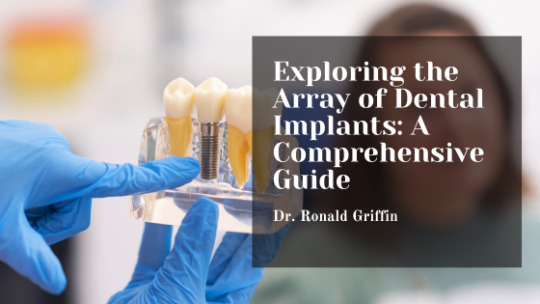
Dental implants have helped revolutionize the field of dentistry, offering a reliable solution for individuals seeking to restore their smiles and oral health. These innovative devices come in various types, each catering to different needs and circumstances. Understanding the different types of dental implants is crucial for both patients and professionals alike. Let’s delve into the diverse world of dental implants:
Endosteal Implants:
Endosteal implants are the most common type and involve placing titanium posts into the jawbone. These implants are sturdy anchors for artificial teeth, offering stability and durability. Endosteal implants are good for most patients with sufficient bone density and volume, making them a popular choice for replacing single teeth, multiple teeth, or even full arches.
Subperiosteal Implants:
Unlike endosteal implants, subperiosteal implants sit on top of the jawbone but beneath the gum tissue. They consist of a metal framework that protrudes through the gums to help hold the artificial tooth or teeth in place. Subperiosteal implants are commonly recommended for patients who lack adequate bone density and are not candidates for bone grafting procedures.
All-on-4 Implants:
All-on-4 implants offer a comprehensive solution for individuals missing all or most of their teeth in a dental arch. This innovative technique involves securing a full set of artificial teeth onto just four strategically placed implants. All-on-4 implants provide significant advantages, including reduced treatment time, minimal bone grafting requirements, and enhanced stability compared to traditional dentures.
Zygomatic Implants:
Zygomatic implants are designed for patients who have experienced major bone loss in the upper jaw, particularly in the area of the maxillary sinuses. Instead of anchoring into the jawbone, zygomatic implants are anchored in the zygomatic bone (cheekbone). This alternative approach enables patients with severe bone loss to benefit from dental implants without the need for extensive bone grafting procedures.
Mini Implants:
Mini implants are smaller in diameter when compared to traditional implants and are often used in situations where there is limited space or bone volume. These implants are suitable for stabilizing removable dentures, providing patients with improved comfort and functionality. Mini implants offer a less invasive option for individuals who may not be candidates for standard implant placement due to bone density issues or medical conditions.
Choosing the right type of dental implant will depend on a variety of factors, including the patient’s oral health, bone density, budget, and treatment goals. Patients must talk to a qualified dental professional who can assess their individual needs and recommend the most appropriate implant solution.
Dental implants offer a diverse range of options to restore smiles and improve oral health. Whether you’re missing a single tooth or an entire arch, a dental implant solution is likely suited to your needs. Understanding the various dental implants available can help patients make informed decisions about their oral healthcare journey and enjoy the benefits of a functional, natural-looking smile for years.
Originally posted on drronaldgriffin.net.
0 notes
Text
A Deeper Look Into How Smoking Affects Your Oral Health
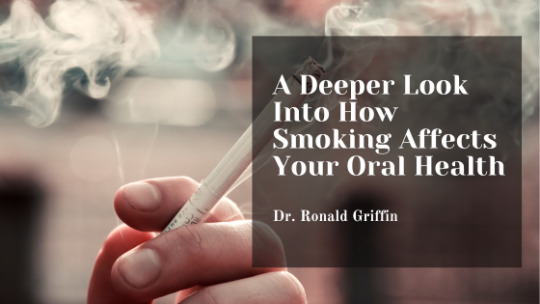
Smoking has been an ingrained habit for many individuals worldwide for decades. Despite increasing awareness of its detrimental effects on health, millions still succumb to the allure of tobacco. While the connection between smoking and lung cancer is well-established, its impact on oral health often goes unnoticed, overshadowed by the more visible consequences on respiratory systems. However, the truth is that smoking wreaks havoc on oral health, causing a cascade of issues that can significantly diminish one’s quality of life.
Let’s delve into the intricate ways in which smoking affects oral health. Firstly, smoking is a primary culprit in the development of periodontal disease, commonly known as gum disease. Tobacco use weakens the immune system, leaving smokers at higher risk of bacterial infections in the gums. This leads to inflammation, swelling, and, eventually, irreversible damage to the tissues and bones supporting the teeth. Consequently, smokers are at a heightened risk of tooth loss and other severe complications stemming from periodontal disease.
Moreover, smoking interferes with the natural healing process of oral tissues. Whether it’s a routine dental procedure or a major surgery, smokers experience slower healing times and are more prone to postoperative infections. This delayed healing not only prolongs discomfort but also increases the likelihood of complications, requiring additional interventions and resources to manage.
The aesthetic repercussions of smoking on oral health are equally distressing. Tobacco stains teeth, giving them a yellowish or brownish hue that is notoriously difficult to remove. Professional whitening treatments may provide temporary relief, but without addressing the underlying cause — smoking — the stains often return, leaving individuals frustrated and self-conscious about their smile. Additionally, smoking accelerates the progression of tooth decay, further diminishing the appeal of one’s dental aesthetics.
Beyond these visible manifestations, smoking significantly elevates the risk of developing oral cancer. The carcinogens present in tobacco products wreak havoc on the cells lining the oral cavity, leading to the formation of malignant tumors. Oral cancer has been known to affect the lips, tongue, cheeks, gums, and throat, posing a grave threat to both oral health and overall well-being. Early detection is crucial for successful treatment, yet smoking often masks the symptoms, leading to delayed diagnosis and poorer prognosis.
The impact of smoking on oral health extends beyond individual suffering; it also exacts a substantial economic toll on society. The costs associated with treating smoking-related dental conditions, including gum disease, tooth decay, and oral cancer, are staggering. From dental consultations and surgeries to rehabilitative procedures and long-term care, the financial burden of smoking-related oral health issues strains healthcare systems and individuals alike.
The negative effects of smoking on oral health are undeniable. From periodontal disease and delayed healing to aesthetic concerns and the heightened risk of oral cancer, tobacco use takes a heavy toll on oral tissues and overall well-being. As such, quitting smoking is not only a favor to oneself but also a vital step towards preserving oral health and enjoying a fulfilling life free from the shackles of tobacco addiction. Remember, your smile is too precious to sacrifice at the altar of smoking.
Originally posted on drronaldgriffin.com.
0 notes
Text
Unveiling the Surprising Benefits of Regular Flossing: Beyond Plaque Removal
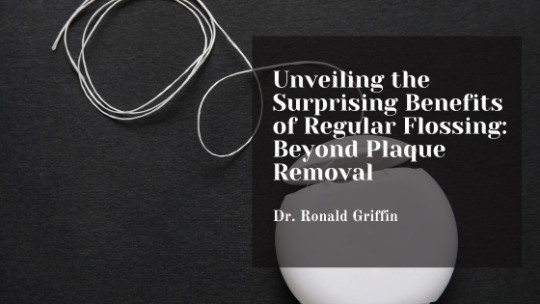
Flossing — it’s the oft-neglected step in oral hygiene routines, overshadowed by the seemingly more crucial brushing of teeth. However, its importance should not be underestimated. While we typically associate flossing with the removal of stubborn plaque and the prevention of gum disease, its benefits extend far beyond that. Learn more about the surprising advantages of regular flossing that go beyond mere oral hygiene.
Gum Disease Prevention: Let’s start with the obvious one — gum disease prevention. When things like food particles and plaque accumulate between teeth, they can lead to gum inflammation and, eventually, gum disease. Flossing helps to remove these particles, reducing the risk of gingivitis and more severe periodontal diseases.
Fresh Breath: Have you ever wondered why your breath feels fresher after flossing? It’s because flossing removes the food debris stuck between teeth, which can eventually contribute to bad breath. By flossing regularly, you’re not just maintaining oral health but also ensuring that your breath stays minty and fresh.
Heart Health: Surprisingly, there’s a link between oral health and heart health. Research suggests that gum disease may increase the risk of heart disease and stroke. While the exact mechanism is still being studied, it’s believed that the bacteria from the mouth can enter the bloodstream and lead to inflammation in the blood vessels, which can eventually cause cardiovascular problems. By taking proper care of your gums through regular flossing, you might also be benefiting your heart.
Diabetes Management: Individuals with diabetes are at a higher risk of gum disease, and gum disease can also potentially make it harder to control blood sugar levels. Therefore, maintaining good oral hygiene, including regular flossing, is essential for diabetic individuals. By reducing inflammation in the gums, flossing may contribute to better diabetes management.
Prevention of Respiratory Infections: Oral bacteria don’t just stay in the mouth — they can travel to other parts of the body, including the respiratory tract. Studies have found that poor oral hygiene, including infrequent flossing, may increase the risk of respiratory infections such as pneumonia. By flossing regularly, you’re not just protecting your teeth and gums but also potentially lowering the risk of respiratory illnesses.
Improved Pregnancy Outcomes: Pregnant individuals are more susceptible to gum disease due to hormonal changes. However, gum disease during pregnancy has been linked to negative outcomes, including preterm birth and low birth weight. By maintaining good oral hygiene practices like regular flossing, pregnant individuals can reduce the risk of gum disease and potentially improve pregnancy outcomes.
Regular flossing offers a myriad of benefits beyond just plaque removal. From preventing gum disease and freshening breath to potentially improving heart health, managing diabetes, and reducing the risk of respiratory infections and adverse pregnancy outcomes, the importance of flossing cannot be overstated. So, next time you reach for your toothbrush, remember to grab that floss, too — your body will thank you for it.
Originally posted on drronaldgriffin.net.
0 notes
Text
Hydration is crucial for overall health and athletic performance, but its impact on dental health is often overlooked. Athletes face unique challenges when it comes to maintaining optimal hydration levels while protecting their teeth and gums. In this article, we'll explore the relationship between hydration and dental health, discussing strategies for balancing performance needs with oral care.
0 notes
Text
Contact sports, like football, basketball, hockey, and soccer, involve physical contact and are known for their intense and competitive nature. While these sports offer numerous benefits, they also pose risks, including dental trauma. Dental injuries are common in contact sports and can range from minor chips and fractures to more severe avulsions and fractures. In this article, we'll explore the types of dental trauma seen in contact sports, how to recognize them, and the appropriate treatment options.
0 notes
Text
When it comes to athletic performance, factors like training, nutrition, and recovery often take center stage. However, one aspect that is often overlooked is oral health. Surprisingly, oral health plays a significant role in overall athletic performance, impacting everything from endurance and recovery to injury prevention and immune function. In this article, we'll explore the connection between oral health and athletic performance, drawing insights from experts in the field.
0 notes
Text
In the world of sports, achieving peak performance requires more than just physical prowess and technical skill. Mental focus, emotional resilience, and psychological well-being play equally important roles in determining an athlete's success. Mindfulness and meditation are powerful tools that athletes can use to sharpen their mental edge, manage stress, and enhance performance on and off the field. In this article, we'll explore the benefits of mindfulness and meditation in sports and provide techniques for athletes to incorporate these practices into their training regimen.
0 notes